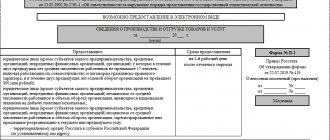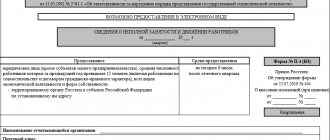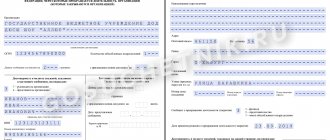Form P-6 to Rosstat in 2022 is included in the list of reports that must be submitted to some legal entities. Since 2022, many forms of statistical reporting have been updated, including form P-6. Where can I get the current form and how to fill it out correctly? What new will the accountant see in this form? You will find answers to these questions and a sample of the completed P-6 form in 2022 in our article.
Also see:
- New form P-3 to Rosstat: form and sample filling from 2020
New form P-6 from 2022
Form P-6 discloses information about the financial investments and liabilities of the enterprise. The standard that needs to be worked with when filling out form P-6 in 2022 is Rosstat order No. 421 dated 07/24/2019. It introduced a new form of form P-6 from 01/01/2020 (in Appendix 11) and gave instructions on how to fill it out.
The current form of form P-6 in 2022 can be downloaded for free via a direct link here:
FORM P-6 IN 2022
There are very few changes. Let's highlight them:
- commented on the procedure for submitting a report by the successor after the reorganization;
- added some concepts that are used when filling out Section 1 of the P-6 form (for example, cash pooling).
Who should submit form P-6 to the statistical authorities
Only legal entities that have financial investments or have carried out transactions with borrowed funds (an observable phenomenon) are required to submit the completed Form P-6. If there is no observed phenomenon in the organization during the reporting quarter, there is no need to submit a zero statistical report to Rosstat. It is enough to notify the department by appropriate letter.
The report is not submitted:
- small businesses;
- government agencies;
- credit and non-credit financial organizations.
If a business entity has separate divisions, filling out form P-6 (statistics) is carried out for the organization as a whole. There is no need to separate data on separate divisions into separate reports. You can clarify the list of statistical reports to be submitted using the Rosstat service, indicating only your TIN or OGRN.
When reorganizing in the form of a transformation, successor organizations submit a report for the period from the beginning of the year in which the reorganization was carried out (including data on the reorganized organization).
Who is required to report on form P-6 in 2020
Form P-6 includes specific data that is not available in the activities of every enterprise. Therefore, not everyone must submit Form P-6 in 2020. Therefore, we will reflect on the diagram respondents of form P-6 and those who are not such:
If the organization does not have financial investments or borrowed funds, it is not necessary to provide a zero P-6 form.
Let us highlight some nuances regarding the presentation of form P-6:
- form P-6 is filled out as a whole for the legal entity without separating data from separate sections into separate reports;
- the successor after reorganization submits form P-6, taking into account the data of the reorganized company, starting from January of the year of reorganization.
On a general basis, legal entities must submit Form P-6:
Deadlines for submitting the report on form P-6 to Rosstat 2022
Form P-6 statistics refers to quarterly reporting. This applies to all categories of respondents, there are no differences.
The report submission date is the same - the 20th day of the month following the reporting period.
Let us present in table form the deadlines that must be met when reporting in Form P-6 in 2022:
| REPORTING PERIOD | DEADLINE: 2022 |
| January – March 2022 | April 20, 2022 |
| January – June 2022 | July 20, 2022 |
| January – September 2022 | October 20, 2022 |
| January – December 2022 | January 20, 2022 |
Form P-6: purpose and obligation to submit
Form P-6 “Information on financial investments and liabilities” is intended for submitting information to Rosstat about the financial investments a legal entity has. The obligation to submit it arises if all organizations with an average number of more than 15 people have such investments (including foreign legal entities operating in the Russian Federation and bankrupt organizations), excluding:
- SMP;
- state and municipal institutions;
- banks;
- insurance organizations;
- non-state pension funds.
Data is entered into it for the organization as a whole, without isolating information on separate divisions, if any.
The form is quarterly, compiled on an accrual basis for each reporting period of the year and submitted to the territorial body of Rosstat no later than the 20th day of the month following the reporting quarter.
Read about the features of accounting for financial investments in the article “Accounting for financial investments - PBU 19/02” .
What to include in the tables of form P-6
When entering data into Form P-6, you should rely on accounting indicators.
Title page
The title must be filled in with information about the organization - name, postal address and OKPO.
Another item to fill out is the reporting period. Form P-6 is filled out with an accrual total. The first month of the period is always January. During the year, only the last month of the reporting period changes: March, June, September, December in reports, respectively, for the first quarter, for half a year, for 9 months, for the year.
Section 1
Section 1 of form P-6 is intended to reflect the financial investments and funds of the company.
What belongs to financial investments and what does not - we will show in the diagram:
Line 010 reflects the total amount of financial investments, broken down into long-term (line 020) and short-term (line 030). Further in the section, line 010 is detailed. From it, the following is distinguished:
The final lines (440-461) of Section 1 of Form P-6 reflect the amount of funds in the enterprise’s cash register and on current accounts - both in rubles and in foreign currency.
The columns of Section 1 reflect the dynamics of changes in financial investments during the reporting period, data at the beginning and end of the period, as well as the amount of income received.
Section 2
Section 2 includes data on borrowed funds.
Line 500 is filled in with the total amount of loans. The following is a line-by-line transcript according to their sources:
- bank loans,
- budget loans,
- loans received from other organizations,
- issued debt securities.
The columns reflect the dynamics of loans in the reporting period, similar to Section 1.
Section 3
Section 3 “Capital and reserves” is filled out only in the report for January-June, that is, based on the results of the six months. This includes data not from the current year, but from the previous year: at its beginning and at its end.
Section 3 reflects information about the authorized capital with detailed details (lines 710-790) and information about own shares purchased from shareholders (page 800).
The numbers in Section 3 of Form P-6 can be correlated with the numbers from the balance sheet:
| LINES OF SECTION 3 OF FORM P-6 | BALANCE BALANCE LINES |
| 700 "Capital and reserves" | 1300 “Total capital” |
| 710 -790 | 1310 “Authorized capital” |
| 800 “Own shares purchased from shareholders” | 1320 “Own shares purchased from shareholders” |
The report ends with a seal, the official’s signature and the date the report was signed.
Structure of form P-6
Form P-6 was approved by Rosstat Order No. 509 dated August 1, 2022. Appendix No. 9 to the Order contains a form for reporting financial investments. Here you will find detailed instructions on how to fill it out. The form itself consists of a title page and three sections. Sections contain information about money and investments, borrowings, reserves and capital. We'll tell you how to fill them out below.
For a legal entity, a generalized form is submitted with disclosure of information on separate divisions.
Title page
There should not be any difficulties filling out the title page. Indicate the period for which you submit reports, the name of the organization, postal address and OKPO company code.
Section 1. Financial investments, funds
Contains information about investments of a legal entity in the form of shares, shares or securities. Let's look at the columns. Column No. 1 reveals the balance at the beginning of the year, columns 2 and 3 contain information about the movement of investments. Column No. 4 is provided for revaluation. Write down all other changes in column 5. In 6, the balance at the end of the year is indicated, and in column 7, indicate the company’s income for the year from the use of financial investments.
There are quite a lot of lines in the first section, but there will be no difficulties with them. Each line reveals your financial investments in more detail. For example, write down the total amount of investments in line 010. On lines 020 and 030, divide financial investments into long-term and short-term. From investments in line 250, you need to separately highlight loans, which on lines 260 and 270 are similarly divided into short-term and long-term. And on lines 280 and 290 they are divided into loans issued to residents and non-residents.
Keep records of exports and imports in the Kontur.Accounting web service. Simple accounting, payroll and reporting in one service.
Section 2. Borrowed funds
The columns in the second section are similar. And information about received loans is already disclosed line by line. For example, you received a loan in the amount of 500 thousand rubles from a non-state pension fund. Then reflect 500 thousand rubles in line 500 “Borrowed funds”, then 540 “Loans received from other organizations”, 560 “Residents” and 570 “Insurers and non-state pension funds”.
There is no difficulty in filling it out, but pay close attention to the subordination structure of the codes. To do this, you can use instructions on how the line is calculated. For example, line 540 is equal to the sum of 550 and 560, which is indicated in parentheses in the column in line 540.
Section 3. Capital and reserves
Complete the previous sections quarterly, and this section only based on the results of January-July of the reporting year.
The number of columns has changed. Now there are only 2 of them - the balances at the beginning and at the end of the previous year.
On line 700, enter the amount of capital and reserves. Indicate the authorized capital in line 710. Lines 720 and 730 disclose the structure of the management company for the share of residents and non-residents. The residents are revealed in even more detail in lines 740-790. If your own shares were bought back, then reflect their value in line 800.
To prepare reports and submit them to Rosstat, use the cloud service Kontur.Accounting. A simple interface will help you quickly fill out and send any reports to regulatory authorities. All newbies are given a free trial period of 14 days.
An example of filling out form P-6 in 2020
Let Principle LLC be one of those firms that are required to submit form P-6 to the territorial statistics body and have indicators in the first quarter of 2022 to fill out the specified report.
At the beginning of 2022, Principle LLC had the following data on financial investments, loans and cash:
- long-term financial investments - a loan to a non-financial resident organization in the amount of 2000 rubles;
- short-term financial investments - bank deposit in a resident bank in the amount of 1000 rubles;
- cash in the cash register – 10,000 rubles;
- funds in the current account – 500,000 rubles;
- interest-free loan from a resident non-financial organization in the amount of RUB 200,000.
During the first quarter, the following occurred at Princip LLC for transactions that are reflected in P-6:
- interest accrued on a long-term loan - 50,000 rubles;
- interest accrued on the deposit - 20,000 rubles;
- received/departed from/to the cash register – RUB 100,000/RUB 95,000;
- received/departed from the current account – 900,000 rubles/750,000 rubles.
Below is a sample of a completed P-6 form in 2022 for the specified example, and below it can be downloaded for free.








